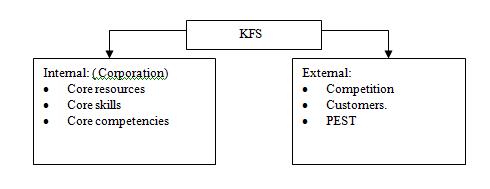- Definition: KFS are those factors that determine a company’s ability to survive and prosper. They help identify potential for competitive advantage.
- Identification: KFS are determined primarily by the analysis of the customer and competitive environment and relating them back to resource and competitive advantage requirements in the corporation. Sometimes this is referred to the 3 C’s (after Ohmae).
- Customers: determine customer needs, segment changes etc.
- Competition: What are the main dimensions of competition; what resources and customers do they have that make them particularly successful; value chain comparisons, etc.
- Corporation: What core resources, skills and competencies does the company have to possess to survive competition and obtain superior competitive advantage.
When KFS have been identified, they can provide a checklist for the rest of the strategic analysis. For example, if we know that a market share of, say, 30% is critical for profitability requirements then any strategy which fails to address this issue is a weak strategy. Similarly, if we know that service levels are crucial to adding value then, again, any strategy that doesn’t address the issue is weak.
3.Core resources, skills and competencies: Within the corporation, the area of core resources, skills and competencies is fundamental to strategy development.
Core resources are identified by Kay as architecture, reputation and innovative ability. They contribute to the distinctive development of a company’s strategy. Architecture is the network of relationships and contracts within and around the firm. Its importance lies in its ability to create knowledge and routines, to respond to market changes and to exchange information. Reputation allows a company to communicate favourable information about itself to customers. It is mainly concerned with long-term relationships and which take a long time to build. For example, reputation for quality service; reputation product excellence, etc. Innovative ability relates to a company’s ability to constantly generate new ideas, think productively, make sound decisions and gain the commitment needed for rapid effective implementation (see notes on Strategic Innovation).
Core skills are a basic fundamental resource of the organisation. They cover the entire value chain. Some writers take this core skill framework into a broader area of people, financial resources and production resources and label them core capabilities.
Core competencies cover an integration of skills, knowledge and technology ( like a three-legged stool). These then build into core products and services, which then form the business areas of the company. This combination can then lead to competitive advantage. Hamel and Prahalad were the authors of a seminal paper on core competencies in 1990. They defined core competencies as “collective learning in the organisation, especially how to coordinate diverse production skills and integrate multiple streams of technologies”. They suggested that there are three areas that distinguish the major core competencies;
- Customer value. Competencies must make a real impact on how the customer perceives the organisation and its products/services.
- Competitor differentiation. Competence must be competitively unique. If the whole industry has the skill then it is not core unless the organisation’s skills in the area are really special.
- Extendable. Core skills need to be capable of providing the basis of products/services that go beyond those currently available.
Importantly, core competencies are a vital prerequisite for the competitive battle that takes place for market share. The development of key resources must come before and not during market place activity.
4.Concluding remarks: The concepts presented here are useful and help strategic thinking to focus not just on external factors but on developing internal differentiators. It is important to realise that they will make a contribution to the development of strategy but they are not panaceas and will need to be treated with caution. Additionally, the language used can be confusing and concepts overlap. It might be useful to think of KFS as made up from external and internal factors.
